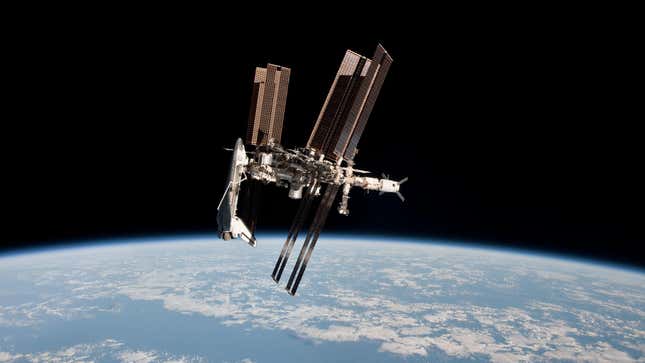
The ongoing shared commitment between Russia and the U.S. for the International Space Station has come under intense pressure due to politics both on and above the Earth, and U.S. officials have reportedly crafted drastic plans in the event Russia decides to suddenly and unilaterally abandon ship.
Reuters reported that NASA has had plans in place that would pull “all astronauts” off the station (presumably U.S. astronauts and those from the European Space Agency, Canadian Space Agency, Japan Aerospace Exploration Agency and other friendly international partners), while somehow finding ways to keep it running if Russia went ahead and removed critical hardware. Such a move might also require the U.S. to scuttle the orbiting laboratory many years ahead of its timed obsolescence in 2030, according to nine anonymous sources Reuters said had knowledge of the plans.
And though Russia’s invasion of Ukraine has only exacerbated tensions between the ISS partner nations, apparently U.S. officials started drafting up these plans late last year, according to the report.
The report gives a better sense of the tension amid the ongoing cold war of words between the U.S. and Russian Federation. NASA and the White House have mentioned this possibility, but have never spoken publicly about what Russia leaving the ISS would mean for its continued operation.

The ISS was designed from the start to be interdependent on both U.S. and Russian technology. Today, the ISS is supported by a vast international consortium of partners, who together “support the operation and management of the International Space Station,” according to NASA. What’s more, operating the ISS “requires physical, hands-on maintenance by the crew, on both U.S. Operating Segment and the Russian Segment, to ensure systems continue functioning,” according to the space agency, adding that “NASA and Roscosmos crew members are not trained to operate each other’s respective segments without onboard assistance.”
As it stands, Russian spacecraft, specifically Progress vehicles, currently provide the propulsion needed by the space station to perform sudden bursts of quick maneuvers (such as dodging space junk). At the same time, U.S. gyroscopes control day-to-day orientation to keep the platform stable. Both countries supply life support systems to the station, allowing for more people aboard at any one time.
Given Russia’s apparent reluctance to stay, NASA and the White House might have to rely on the support of private companies. Reuters said that companies like Boeing have been examining ways to control the ISS without Russian thrusters. A recent test of Northrop Grumman’s Cygnus freighter suggests another possible solution. It’s also worth mentioning the work that actual cosmonauts regularly do to keep the station up and running.
Russia is working on its own orbital service station it hopes to have operational by 2028, while China continues to build out its own space station, known as Tiangong.
In an emailed statement to Gizmodo, NASA declined to comment on the specifics of Reuter’s claims. The space agency instead said it “must always have plans, both normal and contingency, for the safe operations of the International Space Station. The agency is continually looking for new capabilities on the space station and planning for a seamless transition to commercially operated destinations in low-Earth orbit. Doing so allows NASA to concentrate on exploration farther out in to the universe.”
The 20-year ISS partnership between NASA and Roscosmos has been tested as of late, with accusations and condemnations flying back and forth for years, though it has gotten worse recently. In late July, Russian officials made a sudden, eyebrow-raising announcement that they were going to leave the ISS after 2024. The Kremlin quickly backtracked and further said it’s not ready to take their toys home until 2028.
The situation wasn’t helped by previous Roscosmos head Dmitry Rogozin, whose bluster and constant antagonism to the international space community did nothing to quell tensions. On July 15, the Russian government announced they were chucking Rogozin out the airlock and replacing him with the country’s former deputy prime minister Yury Borisov. Borisov previously oversaw the country’s defense industry, so the question remains about how different he will be from his predecessor (spoiler alert: probably not very much).
But of course world powers aren’t the only ones making use of the ISS. Private spaceflight company Axiom Space recently took a trip there, and shortly after NASA released new requirements that all missions to the station be headed by a NASA-trained astronaut. NASA is also very concerned that private companies’ designs for new stations won’t come about until after the ISS is set to be decommissioned.
More: Newly Launched Russian Spy Satellite Might Be Stalking a US Military Satellite.